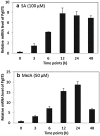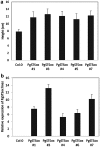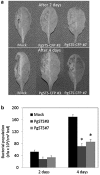Overexpression of Panax ginseng sesquiterpene synthase gene confers tolerance against Pseudomonas syringae pv. tomato in Arabidopsis thaliana
- PMID: 27924121
- PMCID: PMC5120041
- DOI: 10.1007/s12298-016-0384-9
Overexpression of Panax ginseng sesquiterpene synthase gene confers tolerance against Pseudomonas syringae pv. tomato in Arabidopsis thaliana
Abstract
Sesquiterpenes are an abundant group belonging to the terpenoid family, with a C15 structure comprise of three isoprene units. Many sesquiterpenes are volatile compounds and it act as chemical messenger in plant signalling, particularly in the defense mechanism against biotic and abiotic stresses. Panax ginseng Meyer is important medicinal herbs with various reported pharmacological efficacies in which its triterpenoid saponins, called ginsenosides, were mostly studied. However, there have been few studies on volatile sesquiterpenes compounds regulation on P. ginseng. As slow-growing perennial plant, P. ginseng received many kind of stresses during its cultivation. The pathogen attack is one of the most devastated perturbation for ginseng yield. Thus, we aimed to analyze P. ginseng STS gene (PgSTS) expressions in ginseng organs as well as mono-, sesquiterpenes contents from ginseng seedlings treated with elicitors. qRT-PCR and GC-MS analysis showed that two elicitors- salicylic acid (SA) and methyl jasmonate (MeJA) triggered PgSTS expression at different time points and significantly induced mono-, sesquiterpene yield. Overexpression of PgSTS in Arabidopsis also induced high terpene content and conferred tolerance against Pseudomonas syringae pv. tomato infection. These results suggested that PgSTS transcripts are involved in terpenoid biosynthesis in response to environmental stress mediated by MeJA and SA elicitors; thus, generate tolerance against pathogen attack.
Keywords: Gene expression; Ginseng; Methyl jasmonate; Salicylic acid; Sesquiterpene synthase; Terpene content.
Figures









References
LinkOut - more resources
Full Text Sources
Other Literature Sources
Research Materials
Miscellaneous
